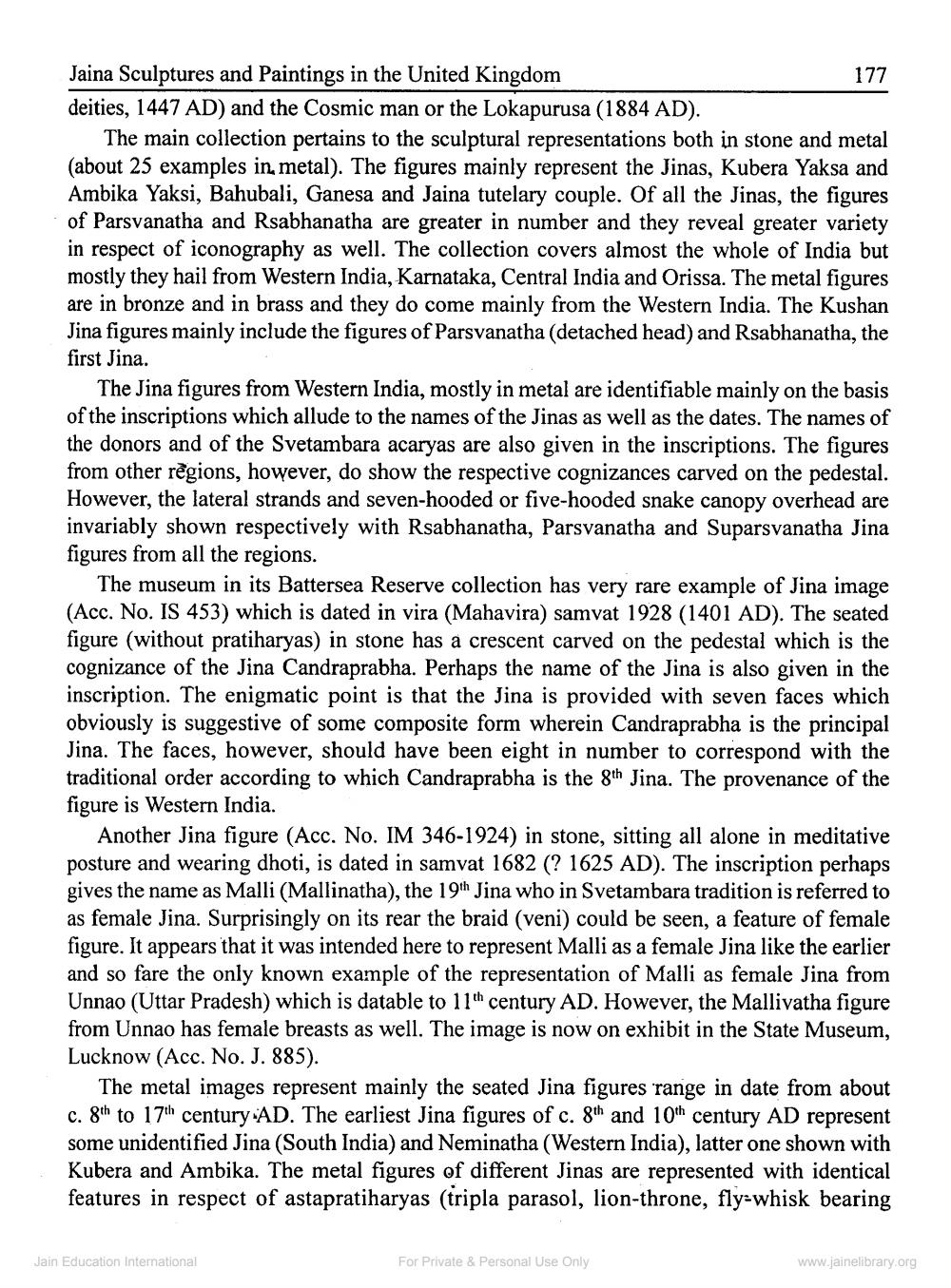________________
Jaina Sculptures and Paintings in the United Kingdom
deities, 1447 AD) and the Cosmic man or the Lokapurusa (1884 AD).
The main collection pertains to the sculptural representations both in stone and metal (about 25 examples in metal). The figures mainly represent the Jinas, Kubera Yaksa and Ambika Yaksi, Bahubali, Ganesa and Jaina tutelary couple. Of all the Jinas, the figures of Parsvanatha and Rsabhanatha are greater in number and they reveal greater variety in respect of iconography as well. The collection covers almost the whole of India but mostly they hail from Western India, Karnataka, Central India and Orissa. The metal figures are in bronze and in brass and they do come mainly from the Western India. The Kushan Jina figures mainly include the figures of Parsvanatha (detached head) and Rsabhanatha, the first Jina.
The Jina figures from Western India, mostly in metal are identifiable mainly on the basis of the inscriptions which allude to the names of the Jinas as well as the dates. The names of the donors and of the Svetambara acaryas are also given in the inscriptions. The figures from other regions, however, do show the respective cognizances carved on the pedestal. However, the lateral strands and seven-hooded or five-hooded snake canopy overhead are invariably shown respectively with Rsabhanatha, Parsvanatha and Suparsvanatha Jina figures from all the regions.
177
The museum in its Battersea Reserve collection has very rare example of Jina image (Acc. No. IS 453) which is dated in vira (Mahavira) samvat 1928 (1401 AD). The seated figure (without pratiharyas) in stone has a crescent carved on the pedestal which is the cognizance of the Jina Candraprabha. Perhaps the name of the Jina is also given in the inscription. The enigmatic point is that the Jina is provided with seven faces which obviously is suggestive of some composite form wherein Candraprabha is the principal Jina. The faces, however, should have been eight in number to correspond with the traditional order according to which Candraprabha is the 8th Jina. The provenance of the figure is Western India.
Another Jina figure (Acc. No. IM 346-1924) in stone, sitting all alone in meditative posture and wearing dhoti, is dated in samvat 1682 (? 1625 AD). The inscription perhaps gives the name as Malli (Mallinatha), the 19th Jina who in Svetambara tradition is referred to as female Jina. Surprisingly on its rear the braid (veni) could be seen, a feature of female figure. It appears that it was intended here to represent Malli as a female Jina like the earlier and so fare the only known example of the representation of Malli as female Jina from Unnao (Uttar Pradesh) which is datable to 11th century AD. However, the Mallivatha figure from Unnao has female breasts as well. The image is now on exhibit in the State Museum, Lucknow (Acc. No. J. 885).
The metal images represent mainly the seated Jina figures range in date from about c. 8th to 17th century AD. The earliest Jina figures of c. 8th and 10th century AD represent some unidentified Jina (South India) and Neminatha (Western India), latter one shown with Kubera and Ambika. The metal figures of different Jinas are represented with identical features in respect of astapratiharyas (tripla parasol, lion-throne, fly-whisk bearing
Jain Education International
For Private & Personal Use Only
www.jainelibrary.org




